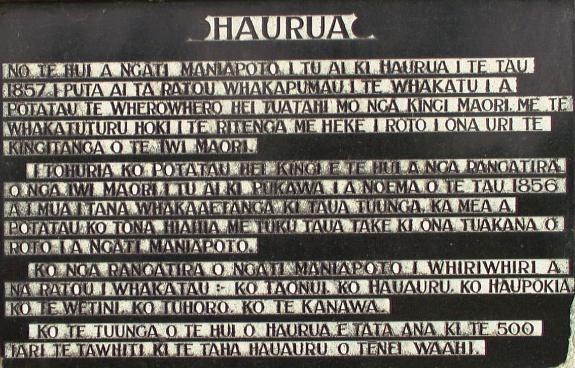Ngāti
1. (personal noun) Prefix for a tribal group, now written as a separate word, e.g. Ngāti Maniapoto.
(Te Kākano Textbook (Ed. 2): 43;)
Ko Ngāti Te Kanawa he hapū nō Ngāti Maniapoto; arā ko ngā uri o Te Kanawa (M 2004:304). / Ngāti Te Kanawa is a sub-tribe of Ngāti Maniapoto; and they are the descendants of Te Kanawa.
Rangiātea
1. (location) a place in Hawaiki and point of final dispersal of some migration canoes. Also a mountain of significance in Ngāti Maniapoto territory.
He matau nāhaku i riua mai i runga o Rangiātea i ngā pora rā e, i rere mai i tawhiti (JPS 1898:172). / A fish-hook of mine brought from Rangiātea in those large sea-going canoes that sailed here from afar.
2. (personal name) house of the males atua, the whatukura, in the uppermost heaven.
Ko te rangi i noho ai te atua, ko Toi-o-ngā-rangi, arā ko Tikitiki-o-rangi. Ko ngā atua e uru atu ana ki reira ko ngā whatukura, he atua tāne. Ko tō rātou whare ko Rangiātea. Ko ngā māreikura, he atua wahine. Ko tō rātou whare ko Te Rauroha (TTT 1/5/1924:38). / The heaven where the atua dwells is Toi-o-ngā-rangi, that is Tikitiki-o-rangi. The atua enter there are the the whatukura, the male atua. Their house is Rangiātea. The māreikura are the female atua. Their house is Te Rauaroha.
Haurua
1. (location) The location of a large hui in 1857 in the Ngāti Maniapoto territory where confirmation of the selection of Pōtatau Te Wherowhero as the first Māori King. It was also affirmed that the Kingship was to be hereditary in his family. Pōtatau had been selected as King at Pūkawa on the western shore of Lake Taupō in November 1856.
(Te Kōhure Textbook (Ed. 2): 1-34; Te Kōhure Video Tapes (Ed. 1): 1;)
kohunga
1. (noun) superior variety of harakeke from Ngāti Maniapoto used for muka. Tall, rather droopy blue-green blades. Glaucous blue-green on underside. Black margin and keel. Many very tall flower heads with small seed pods. Used for the whenu in finest kākahu and for raranga and kete.
Ko te kohunga he harakeke roa, he raupeka ngā whā kānapanapa, he pango ngā tapa me te tuaka, he harakeke tino pai mō te whatu korowai (PK 2008:283). / Kohanga is a long New Zealand flax, the dark green leaves droop, the edges and spine are black and this is an excellent variety for weaving korowai cloaks.
ngutunui
1. (noun) variety of harakeke from Ngāti Maniapoto. Short, bendy variety smudged with reddish shadings on sides and tips of blades. Overall bush has a yellow-bronze appearance particularly in the older leaves. Good for kete and whāriki if blades are long enough. Can produce good muka for whenu in kete, wall-hangings, etc. Said to be highly prized for making fine mats and cloaks.
taeore
1. (noun) variety of harakeke from Ngāti Maniapoto and Opunake. Also called taiore. Tall, bendy, pale blue-green leaves, powdery blue on reverse. Black margins and keel. Many very tall, light-weight flower heads. Fibre used for aho in high quality cloaks. For kete, leaves dry to a pale fawn when boiled and a deeper colour when unboiled. Fibre in muka kete dries to a soft cream colour. Great for raranga.
korowai
1. (noun) cloak ornamented with black twisted tags or thrums - the illustration is of the korowai, Te Whiringa Rongomaiwhiti, woven by Gloria Taituha of Ngāti Maniapoto. The feathers of the korowai are of pūkeko (dark blue) and kererū (white).
Ki te hunga ki tōna whakaaro e tika ana, makere noa ana i a ia te patu pounamu, te kete, te tāniko, te korowai, te tokotoko tae noa ki tana mako tautau, tēnei rā tētahi o āna tino taonga (TTR 1998:208). / He gave to visitors he thought worthy, greenstone clubs, flax baskets, tāniko weaving, korowai cloaks, walking sticks and even one of his priceless shark's-tooth ear pendants.
2. (noun) cloak - in modern Māori this is sometimes used as a general term for cloaks made of muka (New Zealand flax fibre).
He whero ngā huruhuru o te taha whakararo o ngā parirau o te kākā. Ka rangaa he korowai mō te tāngata whakahirahira i ēnei huruhuru (Te Ara 2014). / The feathers under the wings of kākā are red. These feathers were woven into cloaks for important people.


